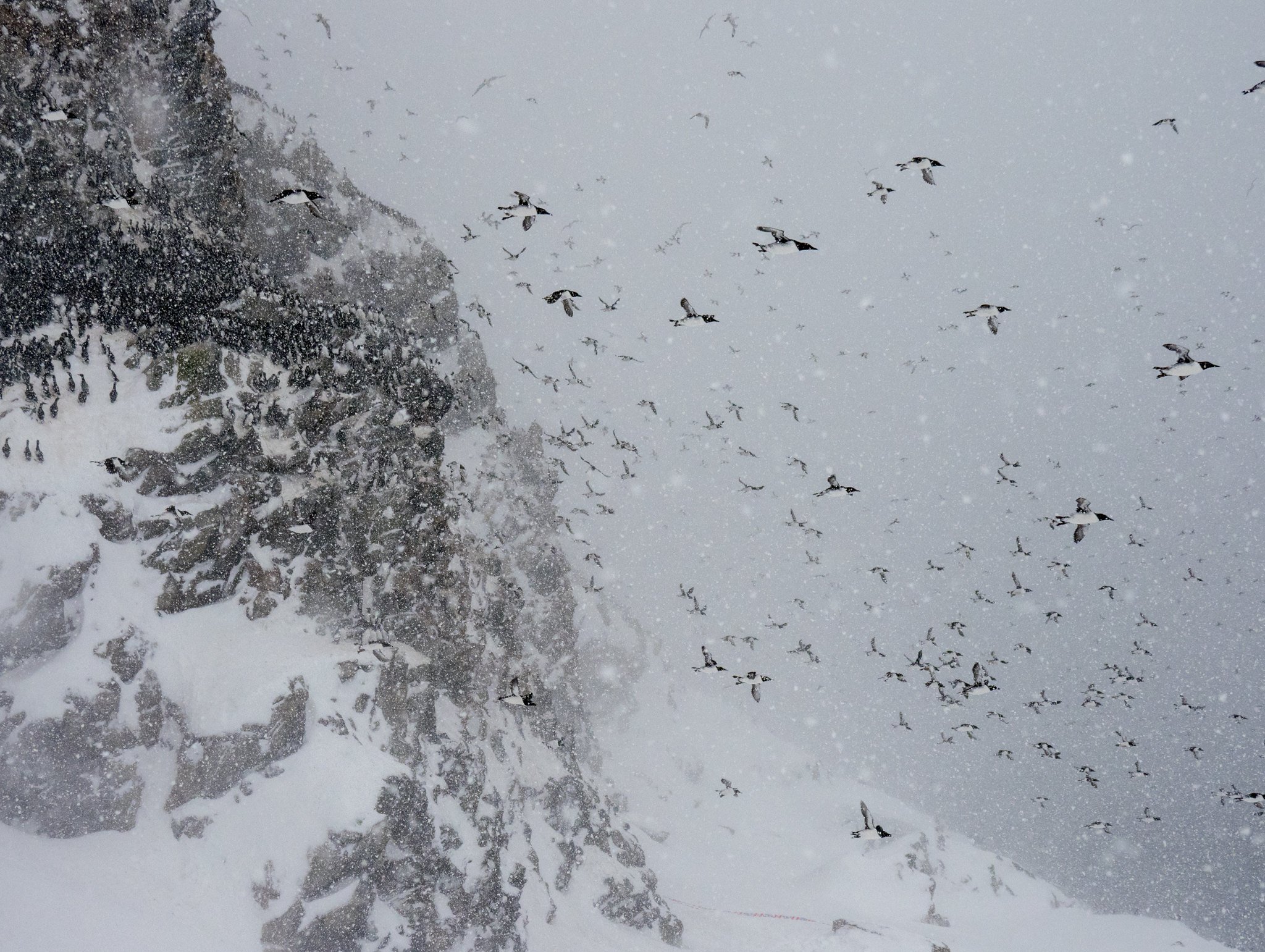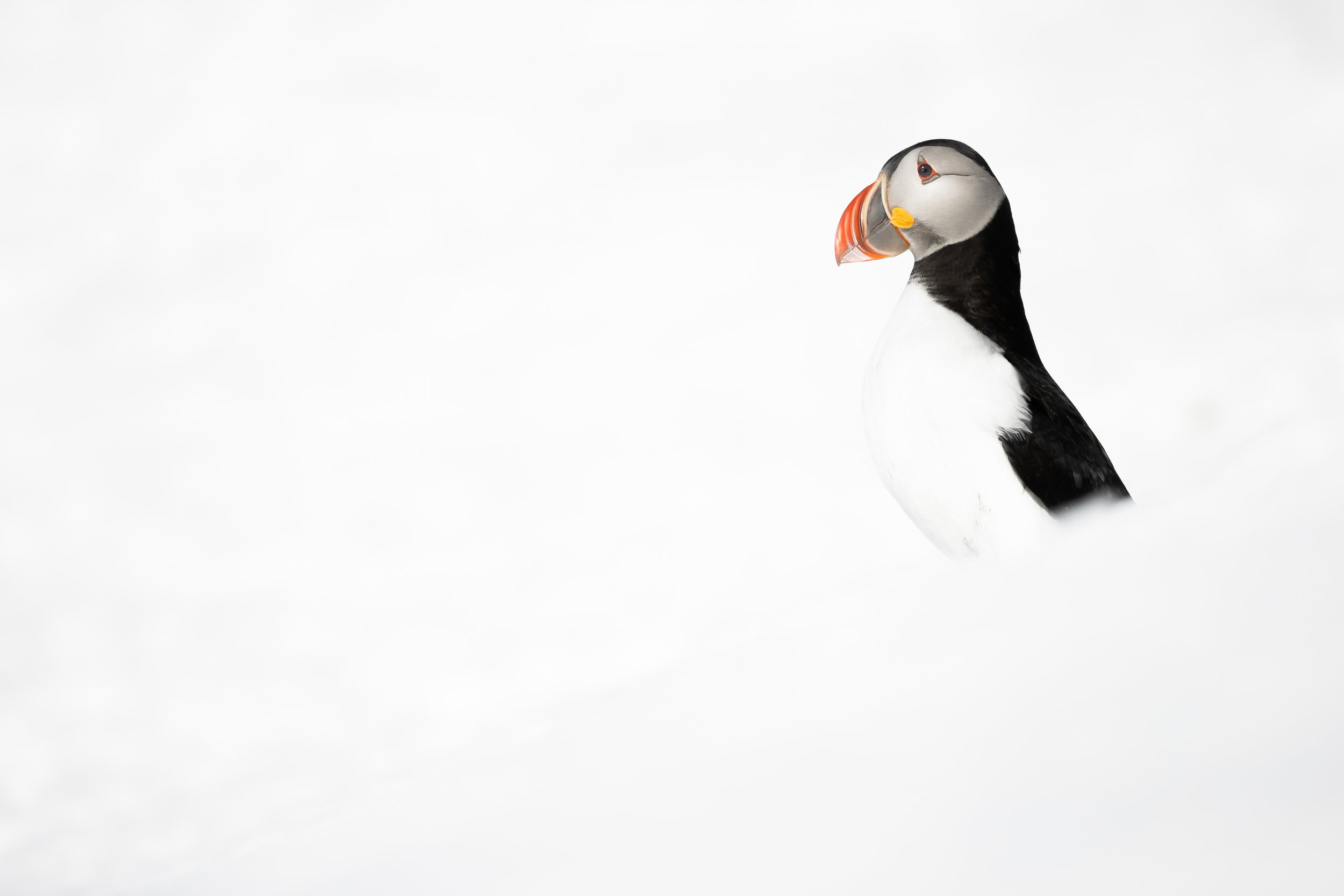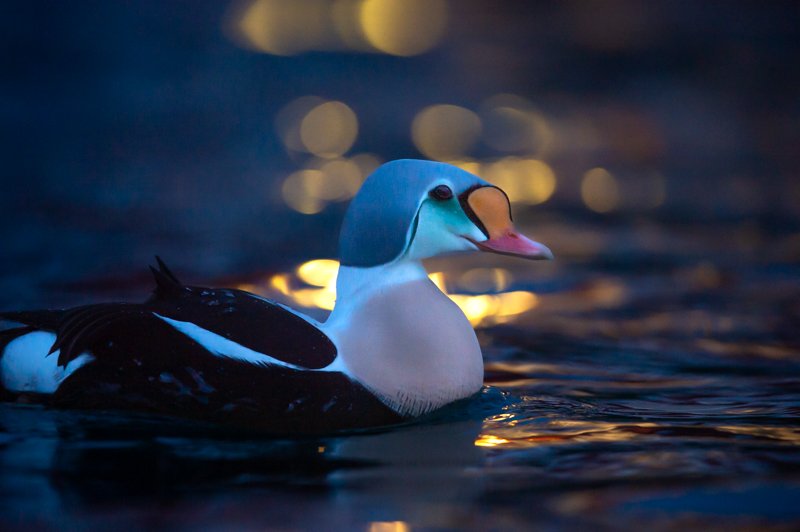
EXPLORE THE FROZEN NORTH
ARCTIC SEADUCKS & PUFFINS
DISCOVER.
LEARN.
INSPIRE.
DATES 2025
27th MARCH - 4th APRIL
LOCATION
NORTHERN FINLAND & NORWAY
PRICE
TBC (inc single supplement)

JOIN AWARD-WINNING SEABIRD PHOTOGRAPHER KEVIN MORGANS, BRYDON THOMASON & JARI PELTOMAKI ON A FANTASTIC ADVENTURE TO THE ARCTIC IN SEARCH OF ITS AMAZING BIRDLIFE.
-
Lapland’s Forest Feeders, Arctic Seabirds & Sea Ducks
From the arboreal Finnish Lapland passerines to Arctic Norway’s seabirds and sea ducks, this exciting itinerary covers a truly unique range of species. Our Arctic adventure begins in Ivalo in northern Finland from where we continue northwards to the north-eastern coastal regions of Batsfjord and eventually, to Vardo and the island of Hornøya.
This program is carefully designed and timed to capture the renowned beauty of winter in the frozen north and its iconic species and, to coincide with the return of Hornøya’s breeding seabirds, which best of all arrive to snow covered-cliff tops.
The headline acts & target species
Heading the bill as this tours main target species/spectacles across this amazing week are; Pine Grosebeak, Siberian Tit and Siberian Jay; Arctic Redpoll, Hawk Owl; King and Steller’s Eider; seabirds on the snow, aurora borealis and, new to the itinerary for 2024, Mountain Hare.
For inspiration, view our trip report and images from last year’s debut tour here, which not only included all the above but also some unexpected highlights such as White-tailed Eagle and Willow Grouse and more.
-
Puffins And Other Arctic Seabirds
Seabirds return from their wintering areas to Hornøya after mid-March. This is an excellent time for photography with lots of action. This is the most accessible seabird colony in Norway, but easily the most spectacular. During the breeding season the island is home to an estimated 80,000-100,000 seabirds during breeding season. Perhaps the most sought-after images here are of Atlantic Puffin, which perform at close proximity on snow, particularly on the lower slopes and foot of the cliffs.
Common Guillemot is easily the most numerous breeder here, the swarms of thousands overhead, particularly when a potential predator soars above is a truly overwhelming spectacle. At certain places in the colony there are incredible opportunities to frame them at close proximity with the colony beyond as a backdrop.
The scarcer Brünnich’s Guillemots prefer the higher ledges of the cliffs but one can still create some great images, particularly in flight. Razorbills, European Shags here also offer unparallelled opportunities as like all their neighbours here, the largely tend to be extremely confiding though we take great care and consideration never to pressure the birds here, ensuring we do not put our images ahead of their welfare. Black-legged Kittiwakes are also found here whilst, if we can keep an eye on the skies overhead, Gyr Falcons and White-tailed Eagles patrol over the island regularly, causing panic among the thousands of alcids.
Arctic Seaducks
The beautifully handsome King Eiders and Steller’s Eiders, Common Eiders and Long-tailed Ducks overwinter in the sheltered harbours of Varanger Peninsula. Though Common Eider and Long-tailed Duck breed in the region, King and Steller’s Eiders move east to the Russian tundra for breeding in spring. Winter months from February to April, when these birds are overwintering in the coasts of Varanger Peninsula, are the best time to photograph them, particularly during this period before their numbers start to fall as birds begin to leave as spring approaches. The floating hides here, (operated by Finnature’s partner, Birdingvaranger) are fantastic. The ducks take advantage of the out-spills from fish factory, often feeding just a few metres from the hides, which offer near eye-level shooting, low across the water. Seats are also provided here for more conventional shooting options.
Forest Feeders
Offering a wonderful contrast to birds of the sea, which is the main focus of this itinerary, we enjoy a morning session at forest feeders at Kaamanen, in Finnish Lapland. Passerines take full advantage of the very well stocked feeding stations here throughout the hard winter months.
Pine Grosebeak is perhaps the most eye-catching of these however specialities such as Siberian Tit and Siberian Jay are also popular whilst Arctic and Common Redpoll are also found in good numbers here. Other species which may also put in an appearance here is Northern Bullfinch, Willow Tit and Lesser-spotted Woodpecker are also regular. With birds on authentic feeders, deep snow and snow-covered tree-branches the photographic opportunities here are excellent, often with birds down to just a few metres- even less from the café window where they are but inches away on the feeders and can be enjoyed with a coffee in hand!
The Highlands
The Highlands of Varanger Peninsula is a harsh environment for any wildlife. Indeed, endless winds and exposure to elements mean a need for special adaptations for any inhabitants. Yet, the barren tundra can offer some superb photo-opportunities. Reindeer, Willow Grouse and Rock Ptarmigan can all be encountered here or even a rare glimpse of a Gyr Falcon or a soaring White-tailed Eagle. The vast and picturesque Arctic landscapes will also draw us to do the occasional picture stop.
ITINERARY
-
For most, the adventure will begin when we meet as a group in Heathrow, before our connecting flight to Helsinki. From there we take an internal flight to Ivalo airport where me meet our guide from our good friends and ground agents on this tour, Finnature.
Dinner and accommodation either at Hotel Ivalo in Ivalo or Neljän Tuulen Tupa Lodge in Kaamanen about 1 hour north of Ivalo, depending on the group size (1 night).
-
Today we begin our journey up into to Northern Norway, but not before we enjoy our first assignment of the tour with the delights of Finnish-Lapland’s iconic passerines at the forest feeders. Here at Kaamanen we spend the morning at the ‘bird café’ where many bird feeders attract wintering passerines such as Pine Grosbeak, Siberian Jay, Siberian Tit, Willow Tit, Common and Arctic Redpoll, as well as numerous Red Squirrels. Birds and Squirrels can be photographed at a close distance.
After our shoot, we continue north and have lunch at the Finnish-Norwegian border. After lunch, we drive to Norway and leave the treeline behind as we cross the highlands of Varanger Peninsula to the small fishing town of Båtsfjord. There is a good chance of Hawk Owl on this, and the next leg of our journey so we keep a keen eye (s!) on the tree tops and power lines along the way.
Dinner and accommodation at Båtsfjord Hotel in Båtsfjord , where we are based for 2 nights.
And tonight, and any other that the skies are clear, we may venture out in the hope of the Northern Lights, if the Aurora activity is good. -
An unsociably early, but assuredly worth it, morning alarm today for the floating hide assignments. The early start and short three to four-minute boat transfer out to the hides ensures we are in place and set up before the ducks return into the harbour at day break. Here, often down to just a few metres we savour the splendour of King Eider and Steller’s Eider, as well as charismatic supporting cast of Common Eider and Long-tailed Duck.
The hides are located in the sheltered Båtsfjord harbor. These renowned photographic hides allow for amazing low-angle photography which we enjoy for a few hours. Late morning we return to the hotel for a warm breakfast. We are later taken out into the fjord where we enjoy the sea ducks from a very different perspective, often huddled together in larger flocks, in flight and against the dramatic backdrop of snow-covered mountains.
Other photogenic subjects and possibilities in Båtsfjord may include Black Guillemot, Purple Sandpiper, Glaucous and Iceland Gull, Raven, and the charismatic fishing village itself but also the amazing Black-legged Kittiwake colonies, which are established along window ledges of harbour-front buildings, a fascinating feature in all the small harbour towns we visit.
Dinner and accommodation at Båtsfjord Hotel in Båtsfjord.
-
Today begins with the exact same time and format as yesterday, which after the early hide session, we return to the hotel for breakfast. After breakfast however, we leave Batsfjor and travel all around the Varanger Peninsula and along the Varanger Fjord to Vardö. On route we take in the stunning sights of the beautiful landscapes and keep a keen eye out for any potential photography stops along the way.
Late afternoon and via a rather impressive tunnel under the sea, we arrive in Vardo.
Dinner and accommodation at Hotel Vardö in Vardö (3 nights).
-
In the morning, we are tantalised by the view of the uninhabited island of Hornoya and weather permitting, we will embark on the first of two visits to this awe-inspiring island. The boat transfer takes just 10-20 minutes (depending on which boat is used). With the excitement of the adventure it is to reach the island, snow blanketing towering cliffs and the skies filled with swarms of seabirds- few seabird cities in the world can match the heady blend you feel on this island. Atlantic Puffins and all their charms on snow is for most, the headline act and yet once here, so unique are the opportunities with the many other species here, it is quite overwhelming- in the very best of ways!
From point-blank portraits, (literally at arm’s length) to wide angle work, placing the approachable birds in their dramatic Arctic environment, to creative use of light and experimental techniques, not to mention the frequent territorial disputes that break out- the opportunities to create powerful imagery is all around us here and is all within a few hundred metres of the landing jetty.
It is estimated that upwards of 100,000 seabirds return to Hornoya each summer. By mid-March Atlantic Puffins, Common and Brünnich’s Guillemots, Razorbills, European Shags, and Black-legged Kittiwakes have usually returned to their breeding cliffs. Having recently arrived back, there is an intensity throughout the colonies as birds are reclaiming nesting sites, rekindling pair bonds and competing for a partner to raise their young.
The sight of Gyrfalcon or White-tailed Eagle is always possible here as they patrol over the island and cause panic among the masses of seabirds. It is not uncommon to see a Gyrfalcon take the occasional unlucky prey.
Weather permitting, we will hope to spend approximately three to five hours each visit. Perhaps not surprisingly up here, strong winds and rough seas can occasionally be an issue in certain wind directions and for this reason. On any given day, boat transfer timings may be governed by changing weather. We keep our third morning in Vardo reserved for another visit, to maximise our chances.
In the evenings we will take half group over two nights for the exciting Mountain Hare hide sessions, situated just 15 minutes from Vardo. This innovative assignment to photograph hare at night, responsibly lit by flash at a feeding station has been carefully over recent years and is fast becoming one of the regions must-do attractions.
During our time in Vardo we may also take time to explore surrounding area where we have a chance of Willow Grouse and Rock Ptarmigan.
Dinner and accommodation at Hotel Vardö in Vardö
-
The morning will be determined by the previous two days visiting Hornoya. With quite a journey ahead of us to travel back to Finland, most of the day is spent traveling, but we hope to make photography stops on the way to break up the journey- a perching Hawk Owl, for example will be too good to miss!
Dinner and accommodation either at Hotel Ivalo in Ivalo or Neljän Tuulen Tupa Lodge in Kaamanen about 1 hour north of Ivalo, depending on the group size (1 night).
-
In the morning we are transferred the short distance for our departure from Ivalo airport and connecting flight to Helsinki.







THE FROZEN NORTH
SHOWCASE
WHATS INCLUDED
Land transportation during the trip
Accomodation
All meals
Guiding and use of professional photography hides
WHATS EXCLUDED
International Flights
Snacks & Alcohol
Personal/Travel Insurance






GET IN TOUCH.
Kevin Morgans Wildlife Photography
Email: kevinmorgans@outlook.com
Phone: 07578798667
